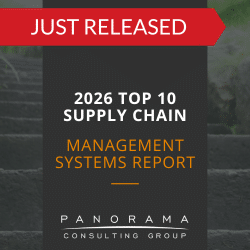Organizational change management (OCM) is a key part of an ERP implementation. Preparing your workforce to use the new tools at their fingertips can maximize user adoption, reduce downtime, and increase your return on investment.
While many organizations agree that OCM is critical, they don’t always take the right approach. In fact, some organizations jump right into OCM without taking the time to create an effective change management communication plan.
If they do end up creating one, it’s a standalone plan that doesn’t relate to an overall change management approach.
Today, we’re sharing how to create a communication plan that will complement your overall change management strategy.
Navigating Change with Rick & Christi
Watch these short and sweet videos to learn about change management from the experts! The series features Rick Platz and Christi Trinder from Panorama’s change management team.
The Complexities of Change Management Communication
First things first. Let’s define organizational change management: What is Change Management?
A communication plan is one aspect of change management.
Creating a change management communication plan might seem easy, but it’s one of the most difficult aspects of the OCM process.
For one, it involves taking the time to establish a framework around your change-based messaging. This framework encompasses more than just telling employees what’s to come; it’s about engaging employees and making them active participants in the project.
Unfortunately, communication plans are often one-sided, based primarily on dictating the change process, rather than creating a collaborative change experience for everyone involved.
At the most basic level, your plan should explain the reason behind the change and address specific employee concerns.
Yet, it doesn’t stop there. You also need to account for individual employee communication, making sure to tailor your message to each specific stakeholder group and each employee’s unique stage in the change cycle.
While the content of this messaging matters, it’s equally important to consider how you’re delivering it. In other words, you should consider factors, such as the timing of each message and the sender delivering each message.
5 Tips for Developing a Change Management Communication Plan
How can you make sure that the change management communication plan you design will be effective? Here are five tips from our experts:
1. Make it Part of a Master Plan and Process
A change management communication plan should be a component of a greater organizational change management strategy, not a replacement for it.
Your communication plan should fit seamlessly with other parts of your change approach, including your:
- Sponsorship roadmap
- Resistance management plan
- End-user training plan
When all these facets (and more) work together, the result is a comprehensive OCM approach that engages employees at every stage of the project.
2. Assign a Dedicated Team
Your software project team will span many different stakeholder groups, including C-suite executives, department managers, and individual employees. The same is true of your OCM communication team.
More specifically, your communication team should be composed of stakeholders from across the organization that can serve as change agents. Overall, you should look for skilled communicators who can make sure your message gets across the right way.
Your team should focus on becoming well-versed in the current and future state of your organization. They should also seek to understand your company’s level of change readiness and help create a culture that embraces new ideas and technologies.
3. Prioritize Individual Perspectives
Change management isn’t a sweeping, universal act. Rather, it’s a more granular movement that starts at the individual employee level. As you create your change management communication plan, keep this perspective in mind.
Everyone won’t look at the change from the same vantage point. Likewise, they won’t all be on the same page throughout the project.
For instance, you might find that some people are still in the initial “change awareness” stage, while others are actively building their skills and competencies in the “ability” stage.
This is why a universal messaging approach isn’t usually effective. Change messages must be customized to individuals.
4. Avoid the Words “Us” and “We”
Communication plans work best when they open up informative dialogues and spur important conversations. This can be difficult to achieve if the bulk of your messages consist of your change team delivering one-way communication.
This type of communication can exacerbate feelings of resentment and frustration, so we recommend talking less and listening more. Be sure to carve out plenty of time to allow employees to ask questions and air their concerns.
While top-down communication is effective at times, it’s also important to encourage bottom-up communication. This gives your end-users the opportunity to share helpful insights into how the new ERP system should work, what features it should include, and what pain points it needs to address.
This is information that your senior leaders won’t have access to unless you have an OCM team that’s actively listening.
Nearly every client we’ve worked with has had several employees who initially resisted change but became supportive of the project once they had the opportunity to communicate their concerns. This communication often took place one-on-one, but sometimes was facilitated through “town hall” meetings.
5. Communicate Continuously
When developing your communication plan, it’s important to look at all phases of the project and time your communication at key intervals.
Relevant information to communicate might include details about upcoming milestones or findings from previous milestones. For example, what business benefits did the company realize from the first phase of the project?
Continuous communication is essential for maintaining employee engagement. As project challenges arise, buy-in naturally fluctuates, so it’s important to repeat key messaging to convey why the gain is worth the temporary pain.
Successful Change Management Starts With Effective Communication
An enterprise software project is only as successful as the people behind it. If your workforce is ready and willing to embrace the new ERP solution, then you avoid unnecessary downtime at go-live. Go-live then becomes a time of rapid benefits realization.
While a change management communication plan can increase your benefits realization, this is only true if your plan is personalized, strategic, and part of an overall change management plan.
Contact our change management consultants below to learn more and to request a free consultation.





![Developing A Change Management Communication Plan [5 Tips]](https://www.panorama-consulting.com/wp-content/uploads/2019/08/change-management-communication-plan.png)








